Attached files
| file | filename |
|---|---|
| 8-K - FORM 8-K - LEAR CORP | k50346e8vk.htm |
| EX-99.1 - EX-99.1 - LEAR CORP | k50346exv99w1.htm |
Exhibit 99.2
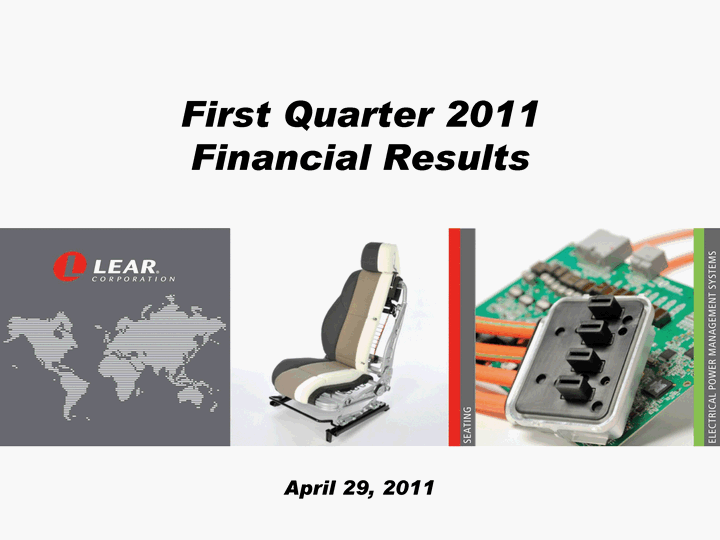
| First Quarter 2011 Financial Results April 29, 2011 Exhibit 99.2 |

| Agenda Company Highlights Bob Rossiter, CEO and President First Quarter 2011 Financial Results and 2011 Outlook Matt Simoncini, SVP and CFO Summary Bob Rossiter, CEO and President Q and A Session 2 |

| Improved operating performance Strong sales growth and profit improvement in both segments Seating achieved target margins for the 4th consecutive quarter Electrical Power Management Systems margins continued to improve Generated positive free cash flow and strengthened credit metrics Ended quarter with $1.7 billion in cash Corporate credit rating upgraded by Standard & Poor's Initiated cash dividend, authorized $400 million share repurchase program and completed two-for-one stock split Continued to win new business First Quarter 2011 Company Highlights* 3 * Free cash flow represents net cash provided by operating activities less capital expenditures. Please see slides titled "Non-GAAP Financial Information" at the end of this presentation for further information. |

| Japan Impact - Situation Continues to Develop* Limited direct impact to Lear No production in Japan; 2010 sales in Japan were 1.6% of Lear total sales Minor damage at one Lear technical office in Atsugi Indirect impacts from part shortages and resulting volume reductions could be significant in the second quarter IHS Automotive expects production disruptions to increase over the next several weeks and to continue into the third quarter IHS Automotive expects most production outside of Japan to be recouped by year-end Japan disaster not expected to impact long-term auto demand Component shortages and production disruptions will create cost inefficiencies Short-term shutdowns result in labor and inventory inefficiencies Recaptured production could result in overtime and other incremental costs 4 * Please see slide titled "Forward-Looking Statements" at the end of this presentation for further information. |

| 5 Lear Vehicle Segment Sales Diversification (By Revenue) Global 2010 Increasing platform diversification Well represented in all vehicle segments globally Lear sales by vehicle segment consistent with overall industry Global 2005 |

| 6 First Quarter 2011 Financial Results |

| Global industry production up 5% reflecting growth in all of our major markets Vehicle production in Japan was down 32% reflecting the impact of the earthquake and tsunami on March 11th Net sales of $3.5 billion, up 20% from a year ago Core operating earnings of $205 million, up 48% from a year ago and the seventh consecutive quarter of year-over-year improvement Free cash flow of $84 million Earnings per share of $1.44, up 136% from a year ago Modest negative impact from Japan disaster in first quarter First Quarter 2011 Lear Financial Summary* * Core operating earnings represents income before interest, other (income) expense, income taxes, restructuring costs and other special items. Please see slides 10 and 13, as well as slides titled "Non-GAAP Financial Information" at the end of this presentation, for further information. 7 |

| First Quarter 2011 Global Vehicle Production Source: IHS Automotive Vehicles Produced (in millions) 8 |

| 9 First Quarter 2011 Reported Financials* * Please see slides titled "Non-GAAP Financial Information" at the end of this presentation for further information. |
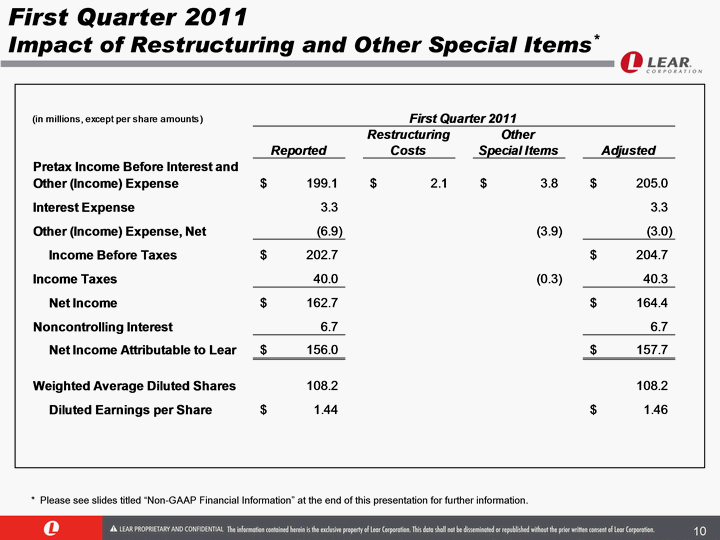
| 10 First Quarter 2011 Impact of Restructuring and Other Special Items* * Please see slides titled "Non-GAAP Financial Information" at the end of this presentation for further information. |

| ** Reported segment earnings represents pretax income before interest and other expense. Adjusted segment earnings represents reported segment earnings adjusted for restructuring costs and other special items. Q1 '11 Q1 '10 $ 2,313.5 $ 2,725.0 $ 149.6 $ 208.5 $ 157.6 $ 210.2 (in millions) Sales Earnings** Adj. Earnings** * Please see slides titled "Non-GAAP Financial Information" at the end of this presentation for further information. 11 Adjusted Segment Margins Explanation of Year-over-Year Change First Quarter 2011 Seating Performance* Sales Factors Sales backlog Higher global vehicle production Selling price reductions Margin Performance Higher global vehicle production and sales backlog Favorable operating performance and restructuring savings Selling price reductions Higher launch and development costs Higher commodity costs |

| ** Reported segment earnings represents pretax income before interest and other expense. Adjusted segment earnings represents reported segment earnings adjusted for restructuring costs and other special items. * Please see slides titled "Non-GAAP Financial Information" at the end of this presentation for further information. 12 Q1 '10 $ 625.0 $ 786.7 $ 25.6 $ 44.1 $ 31.5 $ 44.5 (in millions) Sales Earnings** Adj. Earnings** Adjusted Segment Margins First Quarter 2011 Electrical Power Management Systems Performance* Q1 '11 Explanation of Year-over-Year Change Sales Factors Higher global vehicle production Commodity recovery Selling price reductions Margin Performance Higher global vehicle production Restructuring savings Selling price reductions Higher launch and development costs Higher commodity costs Premium costs associated with industry shortage of microprocessors |

| First Quarter 2011 Free Cash Flow* (in millions) 13 * Please see slides titled "Non-GAAP Financial Information" at the end of this presentation for further information. |

| Recent Shareholder Actions 14 Share Repurchases On February 17th, Lear announced a three-year, $400 million share repurchase program During the first quarter, Lear repurchased $27 million of stock -- 528,998 shares at an average price of $51.84 per share (adjusted to reflect stock split) Cash Dividend On March 16th, Lear paid a quarterly cash dividend of $13 million ($0.25 per share on a pre-split basis) Share Split On March 17th, Lear completed a two-for-one stock split Total cash usage for share repurchases and dividends during the quarter was $40 million |

| Status of Lear Share Count Number of Shares * Common Stock 104.7 million Warrants (0.9 million warrants) 1.8 million Management Shares (shares vest over 3 years based on time and performance) 2.5 million Total Shares, assuming full exercise/vesting 109.0 million Warrants Each Warrant entitles the holder to purchase two shares of Common Stock Warrants are exercisable at an exercise price of $0.005 per share through November 9, 2014, at which time they expire * As of April 2, 2011 15 |
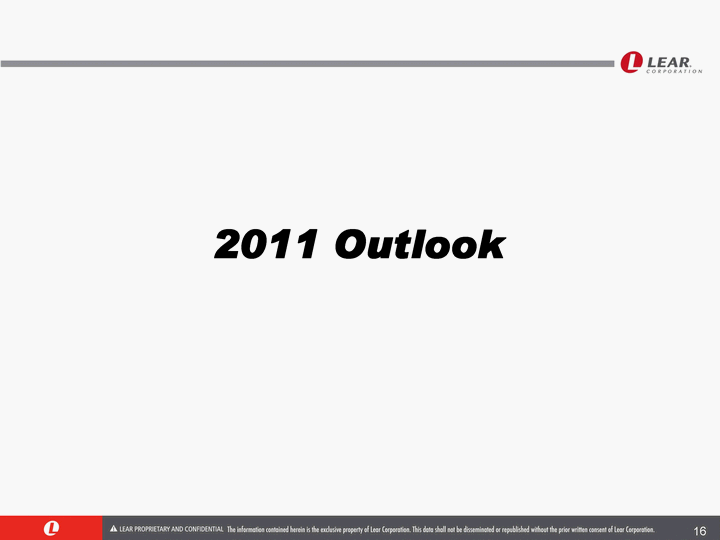
| 16 2011 Outlook |

| Full Year 2011 Outlook Vehicle Production, Euro and Key Commodities* Sources: IHS Automotive and Company estimates Vehicle Production (in millions) * Please see slide titled "Forward-Looking Statements" at the end of this presentation for further information. 17 |
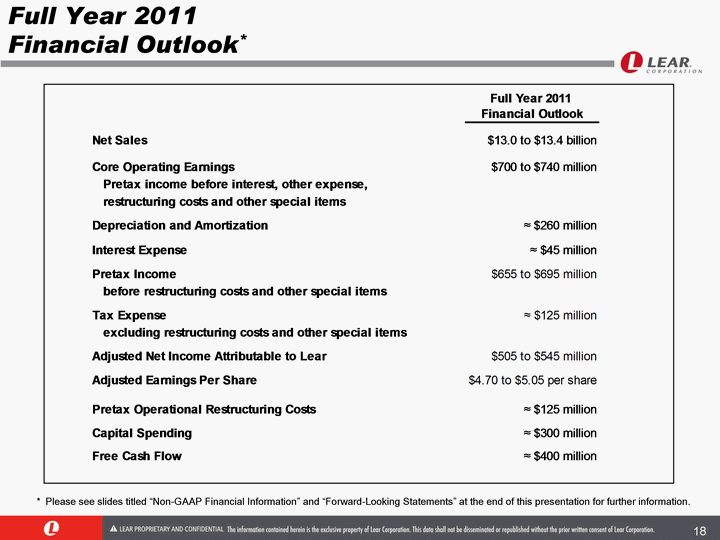
| 18 * Please see slides titled "Non-GAAP Financial Information" and "Forward-Looking Statements" at the end of this presentation for further information. Full Year 2011 Financial Outlook* |

| 19 Summary |

| 2011 off to a strong start with improving financial performance Sales up 20% in the first quarter versus 2010 Margin improvement in both business units Generated strong free cash flow; finished quarter with $1.7 billion in cash and total debt of $699 million Commenced program to return cash to shareholders Cash dividend and share repurchases totaled $40 million during the quarter Completed two-for-one stock split Committed to maintaining investment grade credit metrics Maintaining 2011 financial outlook Anticipate production disruptions in the second quarter related to Japan disaster Expect that a majority of the production will be recovered in the second half of 2011 and that any premium costs can be offset Do not expect negative long-term impact on demand Continuing to win net new business and further diversify sales 20 Summary* * Please see slides titled "Non-GAAP Financial Information" and "Forward-Looking Statements" at the end of this presentation for further information. |

| 21 Non-GAAP Financial Information In addition to the results reported in accordance with accounting principles generally accepted in the United States ("GAAP") included throughout this presentation, the Company has provided information regarding "pretax income before interest and other (income) expense," "income before interest, other (income) expense, income taxes, restructuring costs and other special items" (core operating earnings), "pretax income before restructuring costs and other special items," "adjusted net income attributable to Lear," "adjusted diluted net income per share attributable to Lear" (adjusted earnings per share), "tax expense excluding restructuring costs and other special items" and "free cash flow" (each, a non-GAAP financial measure). Other expense includes, among other things, equity in net income of affiliates, non-income related taxes, foreign exchange gains and losses, gains and losses related to certain derivative instruments and hedging activities and gains and losses on the sales of assets. Adjusted net income attributable to Lear and adjusted earnings per share represent net income attributable to Lear and diluted net income per share attributable to Lear, respectively, adjusted for restructuring costs and other special items, including the tax effect thereon, and other discrete tax items. Free cash flow represents net cash provided by operating activities less capital expenditures. Management believes the non-GAAP financial measures used in this presentation are useful to both management and investors in their analysis of the Company's financial position and results of operations. In particular, management believes that pretax income before interest and other (income) expense, core operating earnings, pretax income before restructuring costs and other special items, adjusted net income attributable to Lear, adjusted earnings per share and tax expense excluding restructuring costs and other special items are useful measures in assessing the Company's financial performance by excluding certain items that are not indicative of the Company's core operating performance or that may obscure trends useful in evaluating the Company's continuing operating activities. Management also believes that these measures are useful to both management and investors in their analysis of the Company's results of operations and provide improved comparability between fiscal periods. Management believes that free cash flow is useful to both management and investors in their analysis of the Company's ability to service and repay its debt. Further, management uses these non-GAAP financial measures for planning and forecasting future periods. Pretax income before interest and other (income) expense, core operating earnings, pretax income before restructuring costs and other special items, adjusted net income attributable to Lear, adjusted earnings per share, tax expense excluding restructuring costs and other special items and free cash flow should not be considered in isolation or as a substitute for pretax income, net income attributable to Lear, diluted net income per share attributable to Lear, cash provided by operating activities or other statement of operations or cash flow statement data prepared in accordance with GAAP or as a measure of profitability or liquidity. In addition, the calculation of free cash flow does not reflect cash used to service debt and therefore, does not reflect funds available for investment or other discretionary uses. Also, these non-GAAP financial measures, as determined and presented by the Company, may not be comparable to related or similarly titled measures reported by other companies. Set forth on the slides 10 and 13, as well as the following slides, are reconciliations of these non-GAAP financial measures to the most directly comparable financial measures calculated and presented in accordance with GAAP. Given the inherent uncertainty regarding special items and other expense in any future period, a reconciliation of forward-looking financial measures to the most directly comparable financial measures calculated and presented in accordance with GAAP is not feasible. The magnitude of these items, however, may be significant. |

| 22 Non-GAAP Financial Information Segment Earnings |
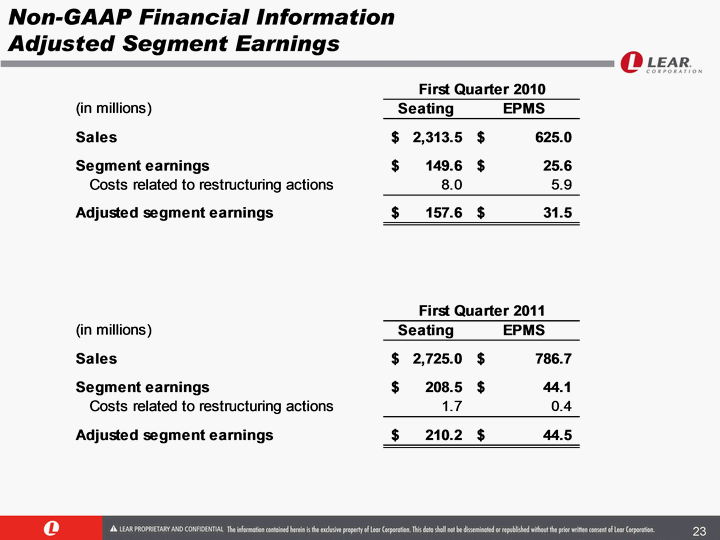
| 23 Non-GAAP Financial Information Adjusted Segment Earnings |

| Forward-Looking Statements This presentation contains forward-looking statements within the meaning of the Private Securities Litigation Reform Act of 1995, including statements regarding anticipated financial results and liquidity. The words "will," "may," "designed to," "outlook," "believes," "should," "anticipates," "plans," "expects," "intends," "estimates," "forecasts" and similar expressions identify certain of these forward-looking statements. The Company also may provide forward- looking statements in oral statements or other written materials released to the public. All such forward-looking statements contained or incorporated in this presentation or in any other public statements which address operating performance, events or developments that the Company expects or anticipates may occur in the future, including, without limitation, statements related to business opportunities, awarded sales contracts, sales backlog and ongoing commercial arrangements, or statements expressing views about future operating results, are forward-looking statements. Actual results may differ materially from any or all forward-looking statements made by the Company. Important factors, risks and uncertainties that may cause actual results to differ materially from anticipated results include, but are not limited to, general economic conditions in the markets in which the Company operates, including changes in interest rates or currency exchange rates; the financial condition and restructuring actions of the Company's customers and suppliers; changes in actual industry vehicle production levels from the Company's current estimates; fluctuations in the production of vehicles or the loss of business with respect to, or the lack of commercial success of, a vehicle model for which the Company is a significant supplier; disruptions in the relationships with the Company's suppliers; labor disputes involving the Company or its significant customers or suppliers or that otherwise affect the Company; the outcome of customer negotiations and the impact of customer-imposed price reductions; the impact and timing of program launch costs and the Company's management of new program launches; the costs, timing and success of restructuring actions; increases in the Company's warranty, product liability or recall costs; risks associated with conducting business in foreign countries; competitive conditions impacting the Company and its key customers and suppliers; the cost and availability of raw materials, energy, commodities and product components and the Company's ability to mitigate such costs; the outcome of legal or regulatory proceedings to which the Company is or may become a party; the impact of pending legislation and regulations or changes in existing federal, state, local or foreign laws or regulations; unanticipated changes in cash flow, including the Company's ability to align its vendor payment terms with those of its customers; limitations imposed by the Company's existing indebtedness and the Company's ability to access capital markets on commercially reasonable terms; impairment charges initiated by adverse industry or market developments; the Company's ability to execute its strategic objectives; changes in discount rates and the actual return on pension assets; costs associated with compliance with environmental laws and regulations; developments or assertions by or against the Company relating to intellectual property rights; the Company's ability to utilize its net operating loss, capital loss and tax credit carryforwards; and other risks described from time to time in the Company's Securities and Exchange Commission filings. Future operating results will be based on various factors, including actual industry production volumes, commodity prices and the Company's success in implementing its operating strategy. This presentation makes reference to the Company's sales backlog. The Company's sales backlog reflects anticipated net sales from formally awarded new programs and open replacement programs, less phased-out and cancelled programs. The calculation of the sales backlog does not reflect customer price reductions on existing or newly awarded programs. The sales backlog may be impacted by various assumptions embedded in the calculation, including vehicle production levels on new and replacement programs, foreign exchange rates and the timing of major program launches. The forward-looking statements in this presentation are made as of the date hereof, and the Company does not assume any obligation to update, amend or clarify them to reflect events, new information or circumstances occurring after the date hereof. 24 |
